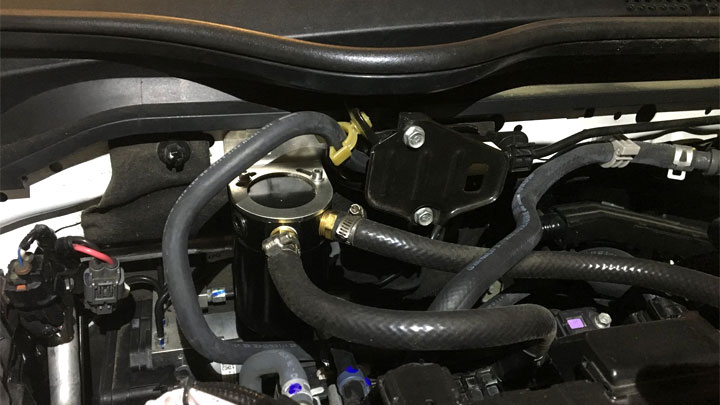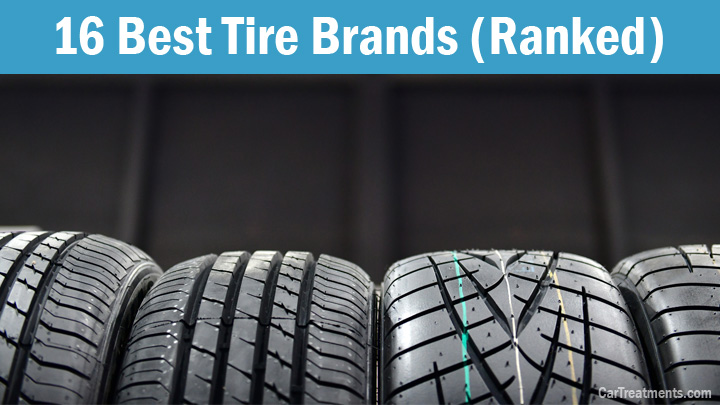Last Updated on July 20, 2022
Car enthusiasts have a number of qualities in common. They tend to be DIY people. They appreciate well-maintained automobiles. They generally favor high performance engines and/or spirited handling. And they often add aftermarket options to their cars.
The oil catch can is just one aftermarket product that a number of enthusiasts have considered for their car’s engine.
In this article we will take a look at this interesting add-on device and ask some serious questions about what it does, whether it is essential, what some of the potential problems might be and some cautions before you buy.
What is Blow-By?
Catch cans are used to manage blow-by. Blow-by is the term for the mixture of fuel, air and combustion products that escape past the piston rings into the engine’s crankcase.
It is during the compression stroke that a small amount of the fuel-air mixture will be pushed across the piston rings. And during the subsequent power stroke a small amount of combustion products will leak past the rings as well.
New or recently rebuilt engines will always have a lower flow rate of blow-by into the crankcase than older engines with worn rings. In either case, blow-by happens. And vehicle manufacturers provide crankcase ventilation systems to manage blow-by and to prevent it from causing excess crankcase pressure.
How Does Crankcase Ventilation Work?
Crankcase ventilation is part of your car’s emissions control system. This system is known as the PCV (positive crankcase ventilation) system.
It utilizes vent ports (generally two) in the crankcase connected to metal and/or flexible tubing to convey blow-by from the crankcase into appropriate ports in the engine’s intake system. The blow-by then flows to the intake and is burned along with the fuel-air mixture.
Related: 5 Bad PCV Valve Symptoms
Why Can Blow-by Be a Problem?
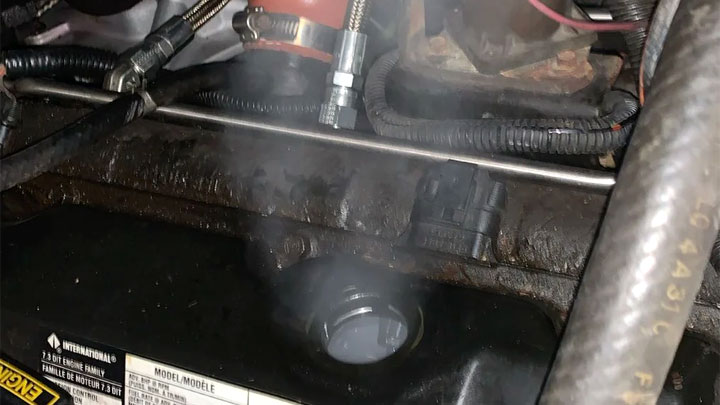
Blow-by is a mixture of vapor and microscopic droplets called aerosols. When this mixture enters the intake system, it flows past each open intake valve and into the combustion chambers. It is this trip past the intake valves where problems may occur.
The blow-by as it passes the valves will impinge on each valve and leave behind a small quantity of the blow-by products (crusty deposits) on each valve. For a port-injected engine or an engine with a carburetor(s), this event poses minimal risk of problems. But for a direct injected engine this can cause costly problems over time.
Port Injected and Carbureted Engines
In these engines, the fuel enters the inlet air flow upstream of the intake valves. As this fuel-rich mixture passes through the intake valves, it cleans each valve and either partially or completely removes the blow-by products that are trying to settle there. This is a beneficial behavior for these types of engines.
Direct Injected Engines
Direct injected engines (known as gas direct injected or GDI) are quite different from port injected or carbureted engines. Direct injection employs fuel injectors inside the combustion chambers.
Fuel is pumped (literally sprayed) at high pressure right into the combustion chambers during the compression stroke. For these engines, no fuel ever passes over the intake valves and thus no beneficial cleaning of the valves takes place.
This type of fuel injection system can allow build-up of blow-by products on the intake valves. These deposits will become ‘baked’ onto the hot valve surfaces, and with many miles (generally 50,000 or more), the deposits can restrict air flow into the combustion chambers. Engine performance will begin to suffer due to this flow restriction.
As more and more car builders adopt gas direct injection, special efforts are required by the engine designers to implement effective ways to manage blow-by.
Managing Blow-by
For some newer cars, the crankcase ventilation systems include internal features that enable some or most of the blow-by to condense or coalesce into a liquid state. Such systems are designed to then drain these liquids directly back into the crankcase.
Thus very little of the liquid products in the blow-by mixture will travel into the intake system and adversely affect the intake valves. Unfortunately, not all cars on the road today have PCV systems with this capability.
Related: Oil In Your Intake Manifold? (Here’s Why)
What Is an Oil Catch Can & What Does It Do?
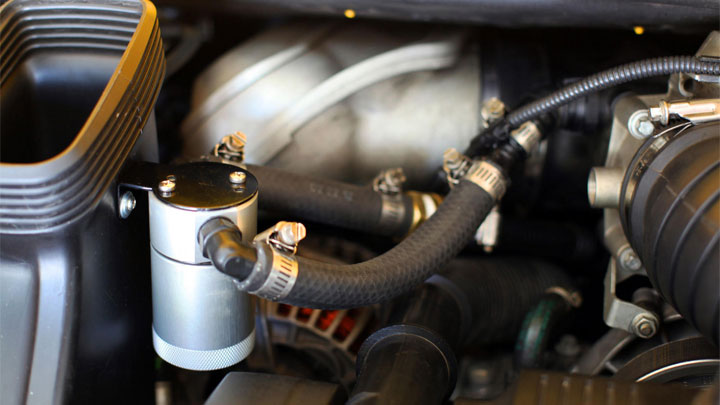
It should now be apparent how blow-by can adversely affect the intake valves for many cars. What can be done to help mitigate this potential problem? Devices called oil catch cans are an effective solution.
Several different styles of catch cans are available. Though different in subtle ways, they all have basically the same features.
The can itself will have inlet and outlet ports, sometimes more than one of each. There will be drain features provided that use either an on-off valve or enable the lower part of the can to be removed for drainage. A catch can kit will include installation parts including a mounting bracket for the can plus the necessary hoses, fittings, clamps, fasteners and installation instructions.
By following the instructions, the can may be installed and connected to the crankcase venting system using the supplied hoses. With the engine running, the flow of crankcase vapors through the can will result in condensation of vapors and conversion of aerosols into a liquid form which will be captured inside the can. This liquid must be periodically drained and properly discarded.
Important: Failure to perform the drainage maintenance step will allow the catch can to completely fill. Then the entrapped fluid will overflow directly into the engine intake. There is potential for such an event to cause severe engine damage.
How Much Does an Oil Catch Can Cost?
Catch can kits can range in cost from as little at $25 and upwards to around $500.
How Often Should a Catch Can be Emptied?
There is no fixed mileage number that would answer this question. If you install a catch can on your car, you should follow the can manufacturer’s guidelines for periodic drainage. If no such guidance is provided, the level of fluid in the catch can should be checked within the first 250 to 500 miles of driving, and the fluid drained at that time.
Use this same drain interval for several cycles until you are comfortable that the can can go longer prior to being emptied. Combining this initial short change interval with actual experience will help you avoid going overly long and having the can overflow into the engine’s intake system.
What Vehicles Will Benefit From a Catch Can?
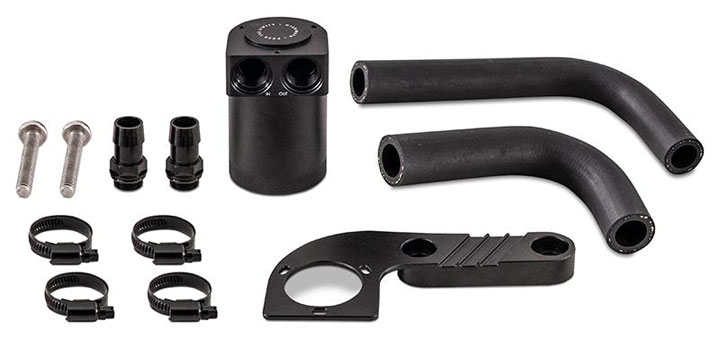
It should be apparent from our discussion so far that any vehicle with a GDI engine should benefit from the installation of an oil catch can.
In addition, vehicles with either port fuel injection or a carburetor(s) can also benefit in some instances because the flow of the crankcase blow-by back into the engine can upset proper fuel-air mixtures and reduce engine efficiency and power.
Does an Oil Catch Can Add Horsepower?
The answer to this question is, possibly, yes. Crankcase blow-by fed directly to the intake system of any engine can adversely affect engine power output by diluting the fuel-air mixture.
Eliminating a portion of the diluting blow-by products through use of a catch can may improve engine power and fuel economy in some cases.
Are Catch Cans Universal?
In general, the answer to this question is, no.
While the same style of catch can might be universal for many engines, the complete kit which would include a can mounting bracket, vent hoses, fittings and fasteners would tend to make each catch can kit specific to each particular make and model of automobile.
Single Valve vs. Dual Valve Catch Cans
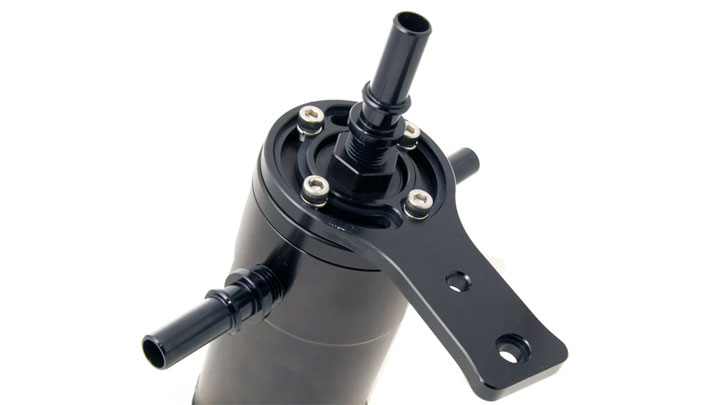
It should be noted that your particular vehicle’s engine may demand either a single or a dual valve catch can configuration. Dual valve catch cans (which often also include internal check valves) are normally fitted to engines that have a turbo or supercharger.
Such engines add the complication of crankcase venting into an intake system that will be pressurized during certain modes of engine operation. Such catch can kits would generally not be compatible with normally aspirated engines.
Where Should the Catch Can Be Installed?
Catch can kits for specific vehicles will provide a recommended location for the can installation. This location should allow access to the can for easy periodic draining.
The can location and tubing must avoid hindering other routine maintenance procedures. And it should not interfere with linkages, belts, hot exhaust manifolds, electrical cables or other hoses routed around the engine compartment.
Once the catch can is installed, save the OEM hoses and/or tubing including all clamps and supports as applicable. Taking photos of the OEM hoses and connections is advised for a record regarding how the OEM parts were installed. You may need to properly reinstall these factory parts at some time in the future.
Are Catch Cans Illegal?
In general, it is deemed illegal to modify the positive crankcase venting (PCV) system on any passenger vehicle since this system is part of the car’s federally-mandated emissions control system. And adding an oil catch can would seem to violate this constraint.
However, there are no aspects of catch can performance that would make the emissions control system inoperative or ineffective. One condition that could be at issue would be the required frequent service to the oil catch can (i.e., periodic draining). Emissions control systems are supposed to require no service for 100,000 miles of driving.
If in your state an annual emissions or vehicle inspection is required, the modifications you have made with an oil catch can installation might be noted. This could result in your car failing that inspection.
If you are concerned about this potential issue, contacting your state’s Department of Motor Vehicles for advice would be recommended.
Read Also: 5 Common Causes of a Failed Emissions Test
Will It Void My Warranty?
Common sense would tell us that there are no features or characteristics of a catch can installation that should put your car’s warranty at risk. However, should you incorrectly install such a device by failing to follow the manufacturer’s instructions, you could conceivably interfere with proper crankcase venting.
This could result in over-pressurizing the crankcase causing premature seal failures, excessive oil consumption and/or other possible problems. Or your inadvertent failure to drain the can such that it overflowed into the engine’s intake system could lead to serious mechanical malfunctions.
Such problems if presented to your dealer in concert with the catch can kit in place would surely result in no warranty coverage. For these reasons, warranty questions should be directed to your dealer’s service department prior to installing an oil catch can kit.
Additionally should you have any doubts about your DIY capability for such an installation, the use of a skilled high performance auto shop familiar with your model vehicle would strongly be recommended.
Cautions Before Buying a Catch Can Kit
Prior to purchasing one of the many oil catch can kits that are available, here are some steps you may want to take to make sure you get a product that fits your needs.
#1 – Download Instructions
If at all possible, download the installation instructions for the catch can that you are interested in buying. With the instructions, you can assess whether you want to perform the installation yourself or find a qualified professional.
#2 – Avoid Kits That Require Altering Existing PCV System
You can also see how the kit interfaces with your engine. Review this carefully because some caution is in order. Here’s why…
The engineers who designed the engine in your car know far more about how that engine functions than any aftermarket supply company. If the catch can kit instructions have you changing any aspects of the existing PCV system in order to use their kit, avoid buying that kit.
For example, if a manufacturer’s instructions tell you to block off one or more PCV ports to install their kit, use of that particular kit is probably not advisable.
Here’s why you should exercise caution. The designers provided the features on your engine for specific reasons. To tamper with those features in any way could have adverse effects on your engine.
Such tampering could make your warranty invalid. And tampering or changing the specific features of your engine’s emissions control system as discussed earlier is illegal.
What Should I Do When I Sell the Car?
You installed a catch can on your car’s engine. And it’s worked flawlessly for several years. Now you are selling or trading in the car. Here’s the issue…
Will the next owner be diligent to perform the periodic draining of the catch can?
The answer here is that you will have no way to ensure this maintenance step will be reliably performed. And as described above, failure to perform this service could lead to severe problems.
Here, the only reasonable solution is to remove the catch can and all associated parts prior to selling or trading in your vehicle. Restore the PCV system hoses, clamps, etc. to the OEM configuration. If you took photos of the factory setup prior to installation, this should be easy.
Returning the area to its factory state is the safest option and will avoid any future liabilities or concerns with respect to the oil catch can system.

